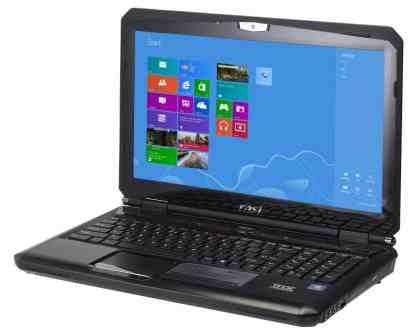MSI's latest gaming laptop takes the very best mobile components AMD has to offer and drops them in a 15in chassis. This is a laptop that should handle even the latest demanding titles. With its dedicated graphics card, Blu-ray optical drive and Full HD display, it should easily cope with your multimedia content too.

Built from a mixture of matt and brushed metal-effect black plastic, its outward appearance is typical of most gaming laptops: it’s big, bulky and aggressively styled. Indeed, the MSI GX60’s chunky edges and protruding heat exhausts add significantly to its size. It's over 5cm thick and weighs a substantial 3.5kg, so you probably won't want to take the GX60 far from a desk.

As you might expect, the chunky chassis has plenty of room for connectivity. As well as three USB3 ports, a fourth USB2 port, multi-format card reader, Blu-ray optical drive, microphone input and three 3.5mm audio outputs for 7.1 surround sound, there are VGA, mini DisplayPort and HDMI video outputs on the rear of the laptop. It also has integrated Wi-Fi and Bluetooth. It also comes with a Killer E2200 gaming-optimised networking interface, which should prioritise VOIP and games traffic over video streaming and downloads, thus improving ping times. In use, we found the Killer networking interface offered little practical improvement over a standard NIC.

The GX60 is equally well equipped inside, with an AMD A10-4600 processor and 8GB of RAM. The CPU runs at 2.3GHz, but can use AMD's Turbo Core technology to reach 3.2GHz when thermal limits allow. It also has almost 900GB zof storage in the form of two 64GB SSDs in RAID and a traditional 750GB hard disk. This should mean it boots Windows 8 quickly, but in practice we reached the desktop after a leisurely 20 seconds. We think the use of a single 128GB SSD would have been a more sensible option.
Unfortunately, the great AMD hardware wasn't enough to put in generate an impressive score in our multimedia benchmarks. It scored a lowly 40 overall, putting it at a significant disadvantage to similar Intel-based laptops. It's able to hold its own for general web browsing, multimedia and office use, and performs significantly better in heavily multi-threaded applications, but there aren't as many of these available as we’d like.
Naturally for a gaming laptop, the GX60 is equipped with a high-end dedicated graphics card. The Radeon HD 7970 is one of the fastest mobile chips that AMD currently produces, so it should come as no surprise that it handled our gaming benchmarks without any trouble. It finished Dirt Showdown with an 46.4fps average, and could even manage a smooth 41fps at 1,920x1,080 with graphics options set to Ultra. Incredibly, you can also connect up to three external displays using AMD's Eyefinity multi-monitor technology and play at ultra-widescreen resolutions. Dirt Showdown managed 36.7fps at 5,760x1080, with 4x anti-aliasing and detail levels set to High. We also tried Crysis 2, where it managed 31fps at 1080p on maximum settings.
Although the GX60 should be able to handle almost any game, we can already see the results appear to be limited by the CPU. The HD 7970 should be capable of more, but the A10 processor isn't able to keep up. The HD 7970 isn't compatible with AMD's hybrid crossfire system either. This means you aren't getting a performance boost from having both AMD graphics and an AMD CPU, making us question whether serious gamers would bother when they could buy an Intel-based machine instead. Brand new titles may need to disable anti-aliasing to get smooth frame rates, and you'll need to lower detail settings significantly if you want to avoid playing a slideshow at Eyefinity resolutions.






Leave a Reply